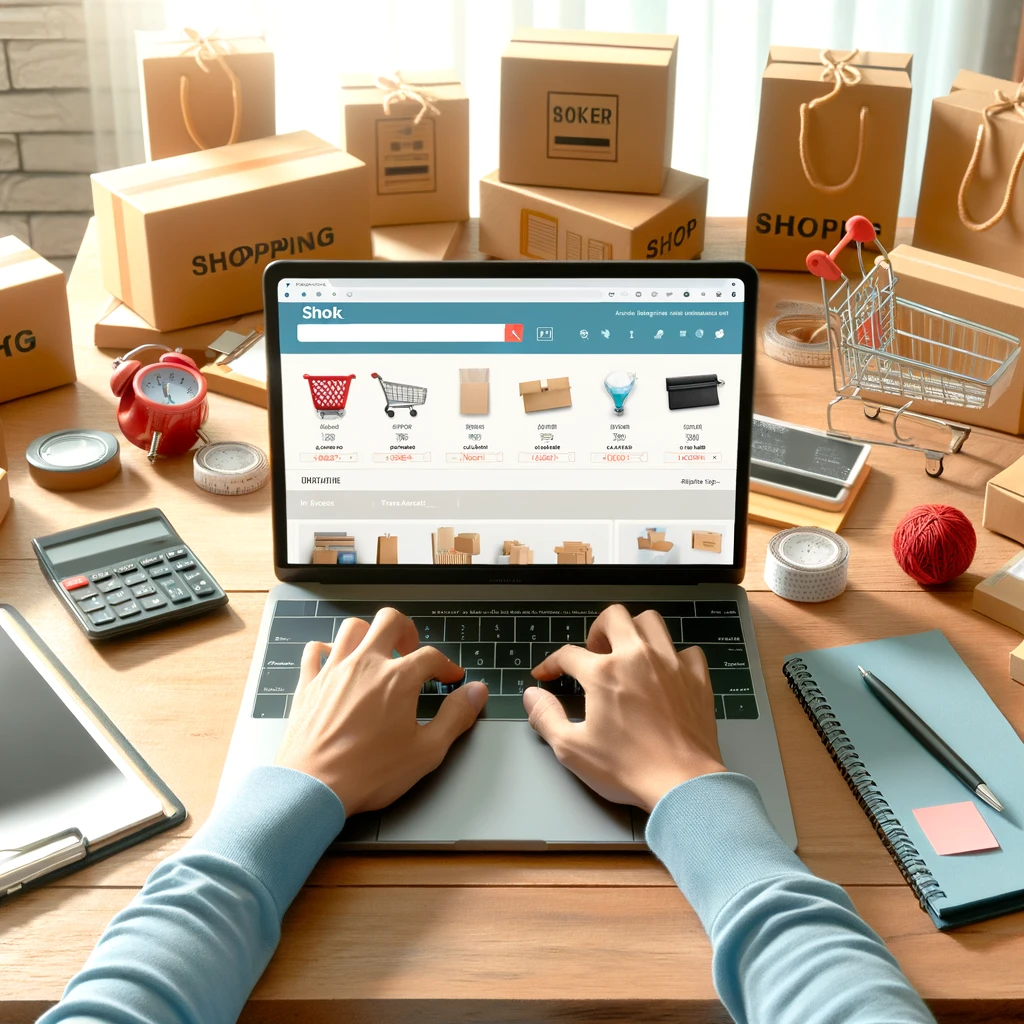In the rapidly evolving digital landscape, e-commerce apps have become a cornerstone of the retail industry. They have revolutionized the way we shop, making it possible to browse, purchase, and receive products with unprecedented convenience and speed. As technology advances and consumer preferences shift, e-commerce apps continue to shape the future of online shopping. This article explores the evolution of e-commerce apps, their impact on the retail industry, key features, leading platforms, and the trends that will define their future.
The Evolution of E-Commerce Apps
Early Days of Online Shopping
The concept of online shopping began to take shape in the 1990s with the advent of the internet. Early e-commerce websites like Amazon and eBay started by offering a limited range of products, primarily books and collectibles. These websites laid the groundwork for the e-commerce boom that would follow.
Rise of Mobile Shopping
With the proliferation of smartphones in the late 2000s, mobile shopping began to gain traction. Consumers increasingly turned to their phones for browsing and purchasing products, leading to the development of mobile-optimized websites and, eventually, dedicated e-commerce apps.
The App Revolution
The launch of Apple’s App Store in 2008 and Google Play in 2012 provided a platform for developers to create specialized e-commerce apps. These apps offered a more seamless and user-friendly shopping experience compared to mobile websites. Features like push notifications, personalized recommendations, and secure mobile payments made shopping via apps more attractive.
Key Features of E-Commerce Apps
E-commerce apps offer a range of features designed to enhance the shopping experience. Here are some key features that make these apps indispensable:
1. User-Friendly Interface
A clean, intuitive interface is crucial for a positive user experience. E-commerce apps prioritize ease of navigation, with well-organized categories, search functionalities, and easy checkout processes.
2. Personalization
Personalization is a significant trend in e-commerce. Apps use data analytics and machine learning to provide personalized product recommendations based on user behavior, preferences, and past purchases. This tailored experience increases customer satisfaction and encourages repeat business.
3. Secure Payment Options
E-commerce apps support multiple payment methods, including credit/debit cards, digital wallets (like PayPal and Apple Pay), and even cryptocurrencies. Secure payment gateways and encryption ensure that customer information is protected.
4. Push Notifications
Push notifications keep users informed about sales, new arrivals, and order updates. These alerts help engage customers and drive sales by prompting them to revisit the app.
5. Augmented Reality (AR)
AR features allow customers to visualize products in their environment before making a purchase. For example, furniture apps let users see how a sofa would look in their living room, enhancing the decision-making process.
6. Wishlist and Favorites
Users can save products they are interested in to wishlists or favorites. This feature helps in tracking desired items and simplifies future purchases.
7. In-App Customer Support
Many e-commerce apps offer in-app customer support through chatbots or live chat features. This immediate assistance enhances customer service and helps resolve issues quickly.
8. Social Media Integration
Integration with social media platforms allows users to share products, reviews, and shopping experiences with their networks. It also enables social login, simplifying the sign-up and login process.
9. Order Tracking
Real-time order tracking gives customers visibility into the status of their deliveries. This feature builds trust and keeps customers informed throughout the shipping process.
Leading E-Commerce Platforms
Several e-commerce apps have become household names, dominating the online shopping landscape. Here are some of the leading platforms:
1. Amazon
Overview: Amazon is the world’s largest e-commerce platform, offering a vast range of products from books and electronics to groceries and fashion. Its app is known for its user-friendly interface and extensive features.
Key Features:
- One-Click Ordering: Simplifies the checkout process.
- Prime Membership: Offers benefits like free shipping, exclusive deals, and access to streaming services.
- Alexa Integration: Voice-activated shopping through Amazon’s virtual assistant.
Impact: Amazon has set the standard for e-commerce, influencing consumer expectations and retail strategies globally.
2. eBay
Overview: eBay started as an online auction site but has since evolved into a major e-commerce platform offering both new and used products.
Key Features:
- Auction and Buy It Now: Options for bidding on items or purchasing immediately.
- Global Shipping Program: Simplifies international purchases and shipping.
- Seller Ratings and Reviews: Builds trust through community feedback.
Impact: eBay provides a unique marketplace for both individuals and businesses to buy and sell a wide variety of goods.
3. Alibaba
Overview: Alibaba is a leading e-commerce platform in China and a major player globally. It offers a wide range of products through its various marketplaces, including Alibaba.com, Taobao, and Tmall.
Key Features:
- Bulk Purchasing: Alibaba.com caters to wholesale buyers with bulk purchasing options.
- Live Streaming: Taobao Live allows sellers to showcase products in real-time.
- Payment Solutions: Integration with Alipay for secure transactions.
Impact: Alibaba has transformed the e-commerce landscape in China and expanded its influence worldwide, particularly in B2B and B2C sectors.
4. Shopify
Overview: Shopify is a platform that enables businesses to create their own online stores. It offers customizable templates and a range of tools to help merchants manage their businesses.
Key Features:
- Customizable Storefronts: Wide range of templates and design options.
- Integrated Payment Processing: Supports various payment methods, including Shopify Payments.
- App Ecosystem: Access to numerous apps that extend functionality.
Impact: Shopify has empowered countless entrepreneurs and businesses to establish an online presence and compete in the digital marketplace.
5. Walmart
Overview: Walmart, a retail giant, has made significant strides in e-commerce with its app and online store. It offers a wide range of products, including groceries, electronics, and household goods.
Key Features:
- Pickup and Delivery: Options for in-store pickup and home delivery.
- Savings Catcher: Price matching to ensure the best deals.
- Walmart+: Subscription service offering free delivery and other perks.
Impact: Walmart’s e-commerce efforts have bolstered its position as a retail leader, providing customers with a seamless shopping experience both online and offline.

The Impact of E-Commerce Apps on Retail
Changing Consumer Behavior
E-commerce apps have fundamentally changed consumer behavior. Shoppers now expect convenience, speed, and personalization in their shopping experiences. Mobile shopping has become a norm, with consumers increasingly relying on their smartphones to make purchases.
Omnichannel Retailing
The rise of e-commerce apps has led to the development of omnichannel retail strategies. Retailers are integrating their online and offline channels to provide a cohesive shopping experience. This includes features like buy online, pick up in-store (BOPIS) and seamless returns across channels.
Data-Driven Insights
E-commerce apps generate vast amounts of data on customer behavior, preferences, and purchase patterns. Retailers use this data to optimize their inventory, marketing strategies, and customer service. Predictive analytics helps in anticipating demand and personalizing the shopping experience.
Competition and Innovation
The competitive nature of the e-commerce industry drives innovation. Retailers continually enhance their apps with new features and technologies to attract and retain customers. This competition benefits consumers, who enjoy a constantly improving shopping experience.
Challenges and Opportunities
While e-commerce apps offer numerous benefits, they also present challenges. High customer expectations for fast delivery and seamless service can strain logistics and operations. Additionally, ensuring data security and privacy is a critical concern.
However, these challenges also present opportunities for innovation. Advances in logistics, such as drone deliveries and automated warehouses, are set to revolutionize order fulfillment. Enhanced cybersecurity measures will build customer trust and protect sensitive information.
Trends Shaping the Future of E-Commerce Apps
1. Artificial Intelligence (AI) and Machine Learning
AI and machine learning are transforming e-commerce apps by enabling advanced personalization, chatbots, and predictive analytics. These technologies enhance the user experience by providing tailored recommendations, efficient customer support, and insights into shopping behavior.
2. Augmented Reality (AR) and Virtual Reality (VR)
AR and VR technologies are set to redefine online shopping by providing immersive experiences. AR allows customers to visualize products in their environment, such as trying on clothes or placing furniture in their homes. VR can create virtual stores where customers can browse and shop in a simulated environment.
3. Voice Commerce
Voice-activated shopping is becoming increasingly popular with the rise of smart speakers and virtual assistants. E-commerce apps are integrating with voice platforms to enable hands-free shopping. Consumers can search for products, place orders, and track deliveries using voice commands.
4. Sustainability and Ethical Shopping
Consumers are becoming more conscious of the environmental and ethical impact of their purchases. E-commerce apps are responding by highlighting eco-friendly products, transparent supply chains, and ethical brands. Features like carbon footprint tracking and sustainable packaging options are gaining traction.
5. Social Commerce
The integration of e-commerce and social media, known as social commerce, is a growing trend. Platforms like Instagram and Facebook are enabling in-app shopping experiences, where users can purchase products directly from social media posts. Influencer partnerships and user-generated content drive this trend.
6. Blockchain Technology
Blockchain technology offers potential solutions for transparency and security in e-commerce. It can provide a transparent and immutable record of transactions, ensuring authenticity and reducing fraud. Blockchain can also streamline supply chain processes and enhance data privacy.
7. Hyper-Personalization
As data analytics and AI advance, hyper-personalization will become more prevalent. E-commerce apps will use detailed customer profiles to offer highly personalized experiences, from product recommendations to tailored marketing campaigns. This level
of personalization enhances customer satisfaction and loyalty.
8. Subscription Models
Subscription-based e-commerce is on the rise, offering customers convenience and value. Apps like Amazon Prime and subscription boxes for various products are becoming popular. These models provide a steady revenue stream for retailers and a seamless shopping experience for consumers.

Conclusion
E-commerce apps have revolutionized the way we shop, offering unparalleled convenience, personalization, and access to a vast array of products. From the early days of online shopping to the sophisticated mobile experiences of today, these apps have continually evolved to meet the changing needs of consumers.
The impact of e-commerce apps extends beyond consumer behavior, driving innovation and competition in the retail industry. Retailers must adapt to the challenges and opportunities presented by mobile shopping, leveraging data, technology, and customer insights to stay competitive.
Looking ahead, the future of e-commerce apps is promising, with trends like AI, AR, voice commerce, and sustainability shaping the next generation of online shopping experiences. As technology continues to advance, e-commerce apps will become even more integrated into our daily lives, offering seamless, immersive, and personalized shopping journeys.
In this ever-evolving digital landscape, e-commerce apps are not just a convenience; they are a fundamental part of the modern retail ecosystem. By embracing these technologies and staying attuned to consumer preferences, retailers can thrive in the future of online shopping, delivering value and satisfaction to customers worldwide.


